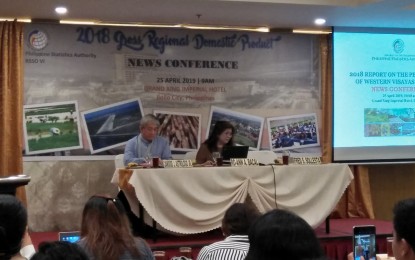
IMPACT OF BORACAY CLOSURE. National Economic and Development Authority Regional Director for Western Visayas Ro-Ann Bacal says the six-month closure of Boracay made a mark in the region’s economic growth in 2018. The Philippine Statistics Authority (PSA) during the presentation of the region’s economic performance on Thursday (April 25, 2019) showed that it has slowed down to 6.1 percent from the 8.6 percent in 2017. (Photo by Perla Lena)
ILOILO CITY -- The six-month temporary closure of Boracay Island was cited as one reason for the slower growth of Western Visayas in 2018 at 6.1 percent compared with the 8.6 percent recorded in 2017.
Regional Director Ro-Ann Bacal of the National Economic and Development Authority (NEDA), citing data, said on Thursday the temporary closure caused tourist arrivals to drop by 15 percent or from 5.8 million in 2017 to 4.9 million in 2018.
Tourist receipts also went down by 18.4 percent.
“The tourism sector impacts on the long chain of demand and supplies transactions, which ultimately is reflected in the GRDP,” she said.
The region’s economy is measured by its the Gross Regional Domestic Product (GRDP). It covers the value of goods and services produce in the region at a given reference period.
The decrease means 900,000 people less coming to Region 6, particularly in Boracay.
This had major impact on transportation, cargo services, labor requirements customers, employment and even in terms of money that is circulating.
In revenues, the LGU lost around PHP57.9 million for six months from terminal and environmental fees.
“The loss of these revenues meant program and projects that would have been charged from this local fiscal resource were not realized,” she cited.
Bacal added that while the effects were “tempered” due to various government interventions, yet “families have to hold back on their spending to prepare for the worst.”
“It is clear that the temporary closure of Boracay made a mark in the slowdown of our economy,” she said.
In Thursday’s news conference about the region’s economic performance, Regional Director Fred S. Sollesta of the Philippine Statistics Authority (PSA) Statistical Services Office 6 revealed that the 6.1 percent growth of Western Visayas is lower than the 6.2 percent national Gross Domestic Product (GDP) growth rate.
“Across regions, GRDP of Region 6 ranked 13th. Region 6 is with four other regions that exhibited a lower growth rates than the national growth rate,” Sollesta said.
Except for Services and Industry sectors showing a positive growth in several of their subsectors, agriculture, hunting, forestry and fishing (AHFF) have declined.
Services, accounted for 58 percent in the region’s economy grew by 7.5 percent, slower when compared with the 2017’s 8.5 percent; The Industry sector also declined with only 8.6 percent from the previous year’s 8.7 percent.
The AHFF, which contributed 17 percent to the regional economy, contracted by 1.4 percent from the 8.8 percent in 2017.
“This is mainly due to the contraction of the agriculture and forestry and the continued decline in fishing,” he said.
However, Bacal said that Western Visayas still remained the country’s fifth largest economy.
She cited that palay and corn production slightly increased. They grew by 0.7 and 8.17 percent, respectively, despite the unfavorable weather condition last year.
The region was the third highest producer of rice in the country after Cagayan Valley and Central Luzon.
She added that the contribution of the industry sector, particularly the construction subsector generated more income-earning opportunities in the countryside. The subsector grew by 14.3 percent compared with the 4.3 percent in 2017.
Bacal is also counting on regional line government agencies to step up the implementation of their projects, to improve on the utilization of their budgets and strictly enforce the provisions of the program of work among contractors”.
“This way we will be able to provide the needed capital outlay for schools, health centers, housing and resettlement, roads and bridges, irrigation projects that are needed in the communities that can spread development in other parts of the region,” she added. (PNA)
